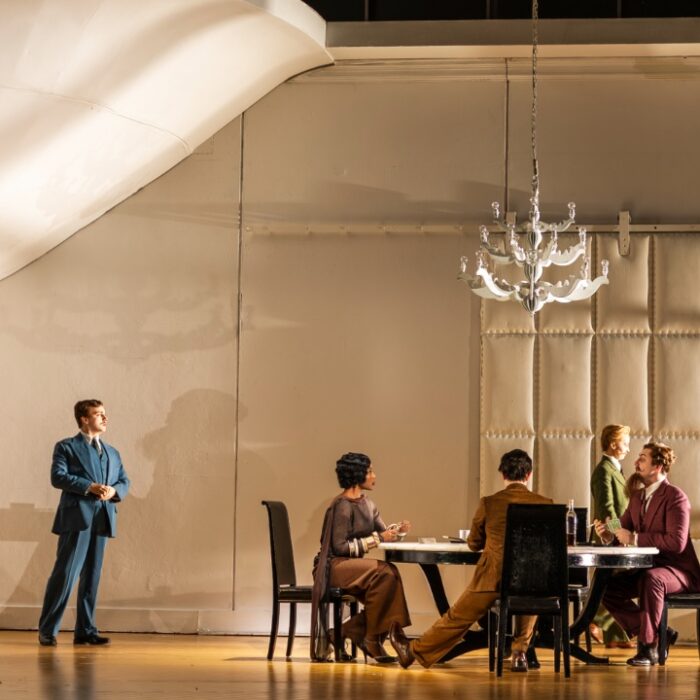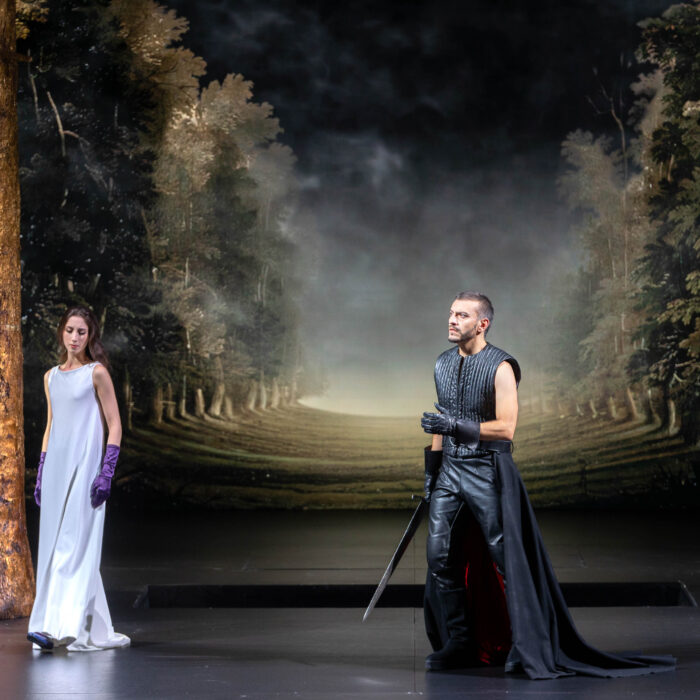
Wexford Festival Opera 2022 Review: La Tempesta
Standout Performance From Manoshvili In Halévy’s Unconvincing Take On Shakespeare’s ‘The Tempest’
By Alan Neilson(Photo: Clive Barda)
Once upon a time, a magician named Prospero was overthrown and expelled from his kingdom by his brother Antonio. He eventually found refuge, with his daughter Miranda, on a small island that belonged to an evil sorceress called Sicorace, whom he imprisoned in a rock, then turned her monstrous son, Calibrano, into his slave. Using his powerful magic, he then commanded the spirit Ariele to conjure up a storm so that a passing ship containing Antonio and his conspirator friends are shipwrecked on his island. Revenge is in the air!
So begins Fromental Halévy’s 1850 opera “La Tempesta,” to a libretto by Eugène Scribe.
A Very Different Narrative
If you are expecting this to be an opera based closely on Shakespeare’s “The Tempest,” then be prepared to be disappointed. The title is the same. The contextual background is the same. The characters, for the most part, are the same. Even the ending, in which all is amicably resolved, is in line with Shakespeare’s play.
The intervening narrative, however, heads off in a new direction, albeit still interwoven with certain aspects of the original storyline.
Calibrano’s mother, the evil Sicorace, who is not present in the play, has an active role in the opera. She plans to escape her imprisonment with the aid of magic flowers, which she gives to Calibrano. He subsequently betrays her and uses them to imprison Ariele in a tree and then to kidnap Miranda, whom he plans to rape. Unfortunately for him, his plan comes to naught. He is waylaid by the shipwrecked sailors and ends up in a drunken stupor, which allows Miranda to escape. But Sicorace has not finished. She convinces Miranda to kill Fernando, but again she is foiled as Fernando reacts in time as Miranda is about to stab him. Love them resumes its happy course.
Moreover, the profiles of the characters are altered. Calibrano and Ariele play more significant roles than in Shakespeare’s play, while the director of events, Prospero, often fades into the background. Antonio, Alfonso, and others are often reduced to little more than incidental characters or are completely eliminated.
In fact, comparisons with Shakespeare’s original play lead nowhere and only frustrate, confuse, or send the mind wandering down rabbit holes; far better to forget Shakespeare completely and engage with Halévy’s opera on its own terms, as a distinct work, no matter how difficult that may prove to be.
Catalano’s Tangential Approach
The director, Roberto Catalano, rather than making the narrative the central focus of presentation, took a tangential approach by basing his reading on Prospero’s motivation: it is not revenge he is seeking but healing. Only by facing the traumatic events of his past will he and the other characters be able to engage positively with the future. So, by bringing his enemies to the island, Prospero is attempting to confront his past by rebuilding his memory of the events that brought him there. The island, therefore, becomes a construction site in the present.
To this end, the scenographer, Emanuele Sinisi, created sets that attempted to lead the audience’s understanding in this direction. There was a large wall with a gaping hole and a cement mixer and bricks next to it, over which was written “Nostalgia.” The past has to be retrieved, rebuilt, and understood so that harmony can be restored.
Moreover, Prospero is the architect, whose guiding hand is responsible for directing all the events that take place on the island. His aim is to enable the other characters to face their own pasts and their own traumas so that they, too, can move forward.
Miranda, for example, is dressed as a young girl in costumes designed by Ilaria Ariemme. Prospero has infantilized her, and she has remained a child. Only through meeting the unbridled lust of Calibrano and the pure love of Fernando can she break free of the past and move forward as a fully-formed adult. Calibrano is presented as a negative mirror image of Prospero, a repository of all that he has rejected and repressed. In a clear piece of symbolism, Ariemme presents him in a brown costume, while Prospero is presented in a white costume. In rejecting his mother’s demands to release her, Calibrano is freeing himself and taking responsibility for his own future.
Without doubt, Catalano’s reading was complex, and it would have been difficult to understand without his program notes. While his interpretation did not detract from the central narrative, which is fairly straightforward and easy to follow, his reading would have been bypassed by those in the audience who had not read them. Moreover, the staging, with its difficult-to-comprehend, subtle symbolism, added a further level of difficulty. Yet with sufficient reflection, they do reveal their meaning. Thus, what initially appeared to be an indulgent, obtuse reading turned out to be a fine, well-staged interpretation, one worthy of the necessary effort needed to appreciate it.
Musically Inconsistent
Halévy is today largely remembered for “La Juive,” one of the cornerstones of French grand opera. “La Tempesta,” however, is an opera on a smaller scale, with a notable Italian influence on its musical structure. It consists of a prologue and three acts rather than five acts, and although there are choral numbers, they are not on the same scale as those found in French grand opera.
Musically, the opera has its moments, with fine arias for Calibrano, Prospero, Stefano, and Miranda, and a pleasing duet for Miranda and Fernando. Dramatically, however, it does not possess the strength to carry the less-than-convincing narrative, nor does it have the punch and sharpness to absorb the full attention of the audience or to engage the emotions on more than a superficial level. Instead, the score is enjoyable and entertaining, if somewhat uneven, but lacks depth and a distinct identity, and as such, is unlikely to remain in the memory.
The conductor, Francesco Cilluffo, however, managed to draw out the work’s full dramatic potential from the Orchestra of Wexford Festival Opera with an energetic yet finely calibrated performance that emphasized its dynamic and rhythmic contrasts. He also maintained a pleasing musical balance, which afforded the singers the necessary space and support to perform.
The Singers Steal The Show
With the direction failing to convince many of the audience, and the inconsistent score often unable to rise above the average, it was left to the singers to rescue the evening. Fortunately, all sang well, with one singer producing a performance of real quality.
That singer was the Georgian bass Giorgi Manoshvili, who was cast as Calibrano. He wowed the audience with his deep, richly colored, resonant voice, which at times felt as if he were enveloping you in a warm, impregnable veil of sound. The voice also has a pleasing degree of versatility, allowing him to deliver wonderfully crafted lines, move seamlessly up and down the scale, and take in leaps without error or any sense of anxiety. His Calibrano was a slow-witted beast, who tended to plod and move slowly around the stage, which suited the character perfectly.
The role of Prospero was not given sufficient weight by Scribe. The impression that he was the circus master overseeing and controlling events was never truly established; the baritone Nikolay Zemlianskikh, who was cast in the role, was always going to struggle. However, he certainly gave it a good shot and impressed with a well-sung, sensitive performance. He possesses a secure voice with a pleasing timbre, which he used intelligently to develop his character.
Last year, soprano Jade Phoenix was a member of the Wexford Factory Program. Such has been her progress over the past year, that not only did she not look out of place in one of the festival’s main operas, but cast in the role of Ariele, she produced one of the evening’s standout performances. The increased confidence she brings to the stage was particularly noticeable, as was the strength of her acting, which impressed. Over the last 12 months, her technique has certainly matured: there is a greater degree of security in her singing, her coloratura has blossomed, lines are constructed with a greater degree of detail and subtlety, and her depth of expression has developed significantly.
Soprano Hila Baggio delivered a professional, well-crafted performance in the role of Miranda. Clearly aware that it was not the perfect role for her voice, she was able to skillfully compensate so that it never became a serious issue. For example, she limited the risks she took with passages of coloratura, but at the same time still managed to make them sound fresh and vibrant whilst restricting the emission of awkward sounds. Her portrayal of Miranda as a child was reasonably convincing, while her transformation, through the love of Fernando, into a young adult was well-presented.
Tenor Giulio Pelligra produced a lyrically pleasing performance as her ardent suitor Fernando, and given that the music he had to work with was, at times, fairly insipid, he did not do a bad job. The duets with Miranda did, however, give him the opportunity to display greater ardor.
Tenor Gianluca Moro, cast as Stefano, caught the attention with his confidently sung drinking song and was successfully able to show off his vocal versatility.
Although mezzo-soprano Emma Jüngling was cast as Sicorace, which is an off-stage role, she made the most of the opportunity with a well-sung performance that showed off the beauty of her voice.
The remainder of the cast, comprising baritone Rory Musgrave as Alonso, Richard Shaffrey as Antonio, and Dan D’Souza as Trinculo, all produced strong performances.
Overall, “La Tempesta” was pleasant enough, but it is certainly not a neglected masterpiece. The music just does not have the dramatic strength or immediacy to hold the attention, except on a superficial level. Although I enjoyed Catalano’s byzantine interpretation, it was clear that many in the audience had little idea as to what was going on beyond the simple narrative. Unfortunately, this is always a possibility when a director relies on program notes to make a production accessible!
However, wonderful performances from many of the singers ensured that the audience went home satisfied.



